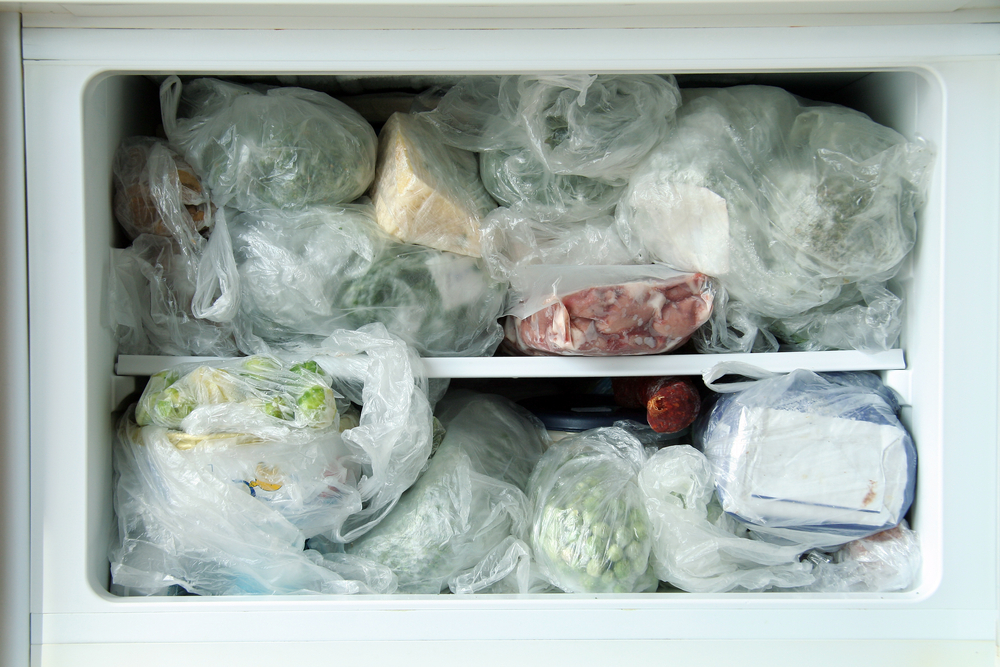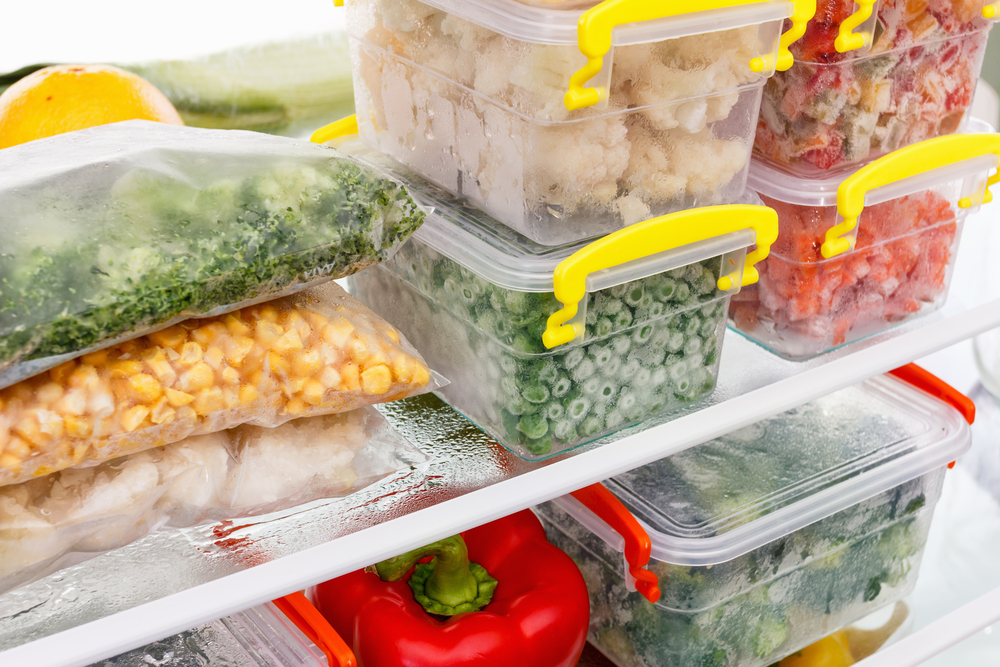While we tend to ensure that our fridges are fairly well organised and regularly decluttered, unfortunately, the same can’t always be said about our freezers. Fortunately, unlike chest freezers, upright freezers are easy to get organised thanks to their multiple easy-to-reach and highly visible compartments. Are you wondering how to get started? Here’s our guide on how to fill an upright freezer.
Step by Step Guide to Filling an Upright Freezer
Step 1: Get Organised
Whether you are the proud owner of a brand new freezer that’s almost empty or your upright freezer has seen better days and is full of unidentifiable frozen produce, you need to plan how to best utilise your freezer.
Set some time aside to go through your freezer contents, defrost it and get rid of anything you are unlikely to consume. If you don’t know what it is or when you freeze it, you’re unlikely to use it. For any salvageable items, label, repack if necessary and store in the correct part of your freezer, which you’ll need to decide upon.
What Goes Where?
As your most frequently used freezer items and entire freezer contents will likely be very different from the next person’s, it’s important to take a few moments to figure out what you are going to put where. As a general guideline, which will vary with your freezer contents, usage habits and compartments, you should respect the following order:
- Upper levels/drawers: Store ice cream; ready meals, and sauces; baked goods; fruits
- Middle levels/drawers: Store vegetables, chips; bread
- Bottom levels/drawers: Store raw meat, fish, seafood and poultry.
Step 2: Portion and Prepare Before Freezing
With your freezer organised and distinct drawers or shelves allocated for certain food types, you now know where to find and place items in the future. Moving forward, as you fill up your upright freezer with food shopping and homemade meals, you’ll want to make sure that you prepare each item correctly to maximise the space in your freezer.
Portion out large packets into usable portions to prevent waste and ensure that it is easy to remove just what you need to create your next meal. If you are freezing food that consists of a large number of individual items, position them on a tray so they are not touching, then freeze them before transferring them to a freezer-safe container or freezer bag. Once they are already frozen, food items won’t stick together, and you’ll save space and packaging by not having to store them separately.
If you are freezing soups, sauces, or similar items such as salsa or ratatouille, you can save space by using reusable ziplock bags for individual portions. Fill the bag and seal it, then lay your filled bag flat inside your freezer on a box or tray. Once frozen completely straight, your ziplock bag of soup or other will be easily stackable.
Step 3: Label and Date Your Items
Do not place anything inside your freezer without labelling and dating it. If you decide to remove any outer packaging from store-bought pre-frozen items, you should cut out the expiry date, defrost and cooking instructions or copy this information over.
After several months in your freezer, you may forget what something is without a clear label. Dates are also important, ensuring that you rotate your freezer contents to use up items before they get out of date.
Step 4: Create a Most Used Items Zone

Most of us have a handful of most used items that we are always nipping in and out of our freezers for. Save yourself time and effort opening multiple compartments and potentially warming up your freezer by creating a shelf or drawer with your most frequently used frozen foods and making life easier. You should not include any raw frozen meat, seafood, fish and poultry – these items should remain in the bottom drawer of your freezer.
Step 5: Keep Track of Your Freezer Stock
How often do you open your fridge and check the dates, and what you’ve got in and then decide to change your dinner plans? As frozen produce has a longer shelf life and we’re less likely to spend as long pursuing the contents of our freezer, we seldom keep track of when most of the food in our freezers is due to expire or has been used up.
Note what you have in your freezer, how long each food item has left and what you’ve used up can help you shop smarter and avoid multiple double or even triple purchases. It’s easy to lose track of what’s in your freezer, so it’s important to either write it down on paper or make a note on your phone.
If you know that you’re running low on chicken breasts and only have a month before they expire, you’ll definitely want to stock up on that next money-saving offer. However, if you didn’t know that you already had three bags of peas with a healthy 12-month expiry date, you may end up buying another couple of bags and find you’re running out of freezer space for other items.
Top Tips on Filling Your Freezer
To make sure that you make the most out of your upright freezer, read through the following tips. While not every tip will be relevant to you, you’re sure to find plenty of useful ideas and advice on stocking up your freezer.
Be Realistic
A lot of us have big ambitions as to how much we’re going to use, freeze, eat etc. If you have just made a large quantity of raw cookie dough, for example, consider just how many you are going to bake right now and how many of those will be eaten immediately. Would it be better to freeze half of your dough and save half a dozen cookies from going stale?
Planning ahead and being realistic about how much food your household will consume will allow you to decide whether or not you can benefit from freezing certain items.
Rotate
Make sure that you store newer additions behind older ones. This will ensure that you waste less food and keep your freezer better organised. Rotating ensures that, even if you have the date clearly written on your freezer bag, you will automatically opt for foods with a nearer use by date.
Don’t Overfill
Freezers are most efficient when they’re full of food, but they also need to have plenty of room for chilled air to circulate. Too much food can prevent this from happening, resulting in insufficiently chilled food, so make sure that you shuffle items around to allow for better air circulation. Keep your freezer stocked at around 85% capacity for optimum performance.
Don’t Underfill
While you don’t want your freezer to be overflowing with frozen goods, ideally, it shouldn’t be running empty either. Your freezer works best when it is well stocked with frozen foods as they help it to maintain its low temperature. If you are planning on changing the freezer or need to run down your freezer supply for another reason, consider using bottles or milk jugs of frozen water to ensure that your freezer stays cold.
Try Stacking Vertically
With your food stored vertically, it is much easier to look through the contents of your freezer. Simply flip these bags to the vertical once you’ve frozen your food flat in plastic bags. This way, you’ll be able to peruse the entire contents of your freezer without worrying about all of the rest of your food falling out. Removing and replacing a vertically stacked bag is much easier than with a horizontally stacked one.
Freeze Bread
Sliced bread, in particular, is an excellent freezer staple, meaning you can still get your slice of toast with your tea in the morning, even when you forgot to pick up bread on the way home.
Limit Air
Removing air from your food’s packaging will help to prevent freezer burn. Ziplock bags allow you to expel excess air just before sealing. You could also try using a layer of aluminium foil or plastic wrap around your food before placing it in suitable containers.
Freezing Fruits
Frozen fruit is a great time saver for smoothies and quick dessert garnishes. Not many people think to freeze fruit, so if you have too many strawberries or bananas to get through, slice them up and allow them to freeze individually in small quantities on a baking sheet in a single layer before tipping them into the freezer bags. This also makes it easier to serve them later than having a huge clump of frozen together slices.
Freezing Dairy Products
Dairy products are not the most freezer-friendly, so it’s worth making a special note. Unlike most other food types, a lot of dairy products lose their original appearance and texture when frozen and defrosted. Here are some of the most common dairy products and whether or not they freeze well.
Suitable for Freezing
- Ice cream
- Butter
- Whipped cream
- Cheeses for salads/cooking – as frozen cheese crumbles when thawed, it’s best reserved for use in cooking or in salads.
Unsuitable/Less Suitable for Freezing
- Soft cheeses
- Unwhipped cream – while unwhipped cream can be frozen, it will separate as milk does, so it is recommended that you whip it before freezing.
- Yoghurt – as the texture will change after defrosting, yoghurt is not suitable for freezing unless you will be consuming it mixed or frozen, for example, in a smoothie or as a frozen yoghurt drink/dessert.
- Milk – freezing milk is safe, but it will cause it to separate, altering its appearance and texture. Although it will still be safe to consume, it can become grainy and watery.
Correct Temperature

For peace of mind, a freezer thermometer will enable you to check that your freezer is operating correctly. Suppose too much cold air escapes during a power cut, and your freezer can’t hold a sufficiently cold temperature anymore. In that case, a freezer thermometer will enable you to keep an eye on your freezer temperature and decide whether or not the content needs to be eaten promptly.
Vacuum Pack Before Freezing
A vacuum seal not only ensures that your food will last for longer, but it is also a great way to save space and prevent freezer burn. If you regularly freeze food rather than buy frozen food, a vacuum sealer is a useful appliance to invest in. Since it ensures you remove as much air as possible when portioning and packaging your food for the freezer.
Use a Freezer Inventory App
Whether you have a big freezer or a small upright freezer, using a freezer inventory app can help you to keep track of the different foods in your freezer, as well as use-by dates and what you need to stock up on more food. Taking a couple of minutes per day to update your app will also help you make sure that you have enough room to accommodate any extra items, ensure that your shopping trips are better organised, and always have the essentials to hand in.
Give Fresh Items Extra Room
When you are freezing food, in particular large items, make sure that you leave sufficient space for cold air to circulate and quickly freeze to better preserve food. Once frozen, you can then pack it in more tightly with the rest of your frozen foods for more space.
Fill Your Freezer Properly
The best way to fill a freezer involves some planning and basic organisational skills. Learning how to fill an upright freezer correctly will allow you to maximise your freezer’s capacity while also making sure that you can easily keep track of your freezer contents. In the long term, all of this will help you to save time and money, plus you’ll always have a selection of meals that you can fall back on even when you’re too busy to go shopping.

